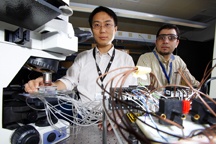Apr 21 2009
Researchers have designed a lab on a chip capable of being programmed to perform a variety of jobs, a step toward more widespread use of the miniature analytical tools used to measure everything from blood glucose to viruses, bacteria to genes.
 Purdue graduate students Han-Sheng Chuang and Ahmed Amin use a microscope and other equipment to watch the performance of a prototype lab on a chip capable of being programmed to carry out a variety of jobs. The innovation is a step toward more widespread use of the miniature analytical tools used to measure everything from blood glucose to viruses and bacteria to genes. (Purdue News Service photo/Andrew Hancock)
Purdue graduate students Han-Sheng Chuang and Ahmed Amin use a microscope and other equipment to watch the performance of a prototype lab on a chip capable of being programmed to carry out a variety of jobs. The innovation is a step toward more widespread use of the miniature analytical tools used to measure everything from blood glucose to viruses and bacteria to genes. (Purdue News Service photo/Andrew Hancock)
Current lab-on-a-chip technology is expensive and time-consuming to develop because each chip must be specifically designed to perform certain assays, or chemical analyses.
Researchers at Purdue University have developed both the hardware and software to create a more versatile chip capable of being programmed for any number of tasks, said Steven T. Wereley, an associate professor of mechanical engineering.
Doctoral students Han-Sheng Chuang and Ahmed Amin have worked with Wereley to create a prototype programmable chip, in research at the Birck Nanotechnology Center in Purdue's Discovery Park. The students and other members of the research team have published four technical papers on the work since 2007, and their business plan for commercializing the technology was awarded a top prize in February during Purdue's 22nd annual Burton D. Morgan Business Plan Competition.
The work is part of a National Science Foundation-funded collaboration that also includes assistant professor Mithuna Thottethodi and associate professor T. N. Vijaykumar, both in Purdue's School of Electrical and Computer Engineering, and Stephen Jacobson, an associate professor of chemistry at Indiana University.
Lab-on-a-chip technology currently is being used for various applications in medicine and research. The systems are used for measuring specific types of cells and molecules in a patient's blood, monitoring microorganisms such as bacteria and fungi in the environment and separating biological molecules for laboratory analyses.
But the chips, which are roughly palm-size or smaller, are difficult to design and manufacture.
"With conventional technology, you have to design the individual layout of the chip, fabricate it, test it and then redesign it when testing uncovers problems," Wereley said. "You are talking about a lot of time, effort and expense that could be dramatically reduced by having a multipurpose programmable chip."
For the life scientists who primarily use the technology, the devices are labor-intensive to develop and use.
"Imagine if running a word processing application on your computer required you to go to the lab and design your own microprocessor for that specific application," Amin said. "Instead, wouldn't it be better if you could just buy a multipurpose chip and download the software you needed? That's what we're going to do -- make it easier to use so that the life scientists using the chips can concentrate on their own work instead of chip design."
Researchers at the Massachusetts Institute of Technology first suggested the idea of applying computer programming concepts to lab-on-a-chip technology in 2004.
"They have focused on programming-language aspects, while we're taking the idea to realization by focusing on the hardware and the software-hardware interface," Amin said. "We have developed the software compiler and the runtime system that would automatically understand a program and convert it into signals to control more complex chips."
The new chip is made out of a rubber-like polymer, called polydimethylsiloxane, instead of the rigid glass or silicon wafers often used. The flexible material is needed because pumps used to direct the flow of fluid operate with moving diaphragms.
Most other chips have the polymer layer sandwiched between two glass layers.
"We chose to build the whole chip out of the PDMS polymer, which makes it easier to fabricate and reduces cost over other alternatives, such as silicon or glass," Chuang said.
The Purdue-designed chip is able to mix, store, heat and sense what the sample is made of, whereas previous programmable chips have been limited to mixing and storing samples.
The researchers have demonstrated how the chip works using a mock sample and reagent dyed with food coloring.
The programmable chips are likely to be commercially available within five years, said Amin, a student in the School of Electrical and Computer Engineering who developed the programming language and "architecture," or interface between the hardware and software.
The language enables the "assay protocols" required for specific tasks to be downloaded to the chip.
Purdue has applied for a provisional patent on the technology.
"What we eventually aim to do is create different classes of chips, where each class can run multiple assays from a few related life-science domains," Amin said.
Lab-on-a-chip technology uses "microfluidics," or precisely controlling and manipulating fluids with miniature channels and other components. The devices contain two major parts: an electronic control portion and a portion consisting of "fluidic functional units," or components for storing, transporting, mixing and heating samples. These units are connected by tiny channels in which the fluid path is controlled by using special pumps to open and close miniature valves.
Chuang, a student in the School of Mechanical Engineering, has led work to develop hardware for the new programmable chip, creating a single chip that contains a multipurpose arrangement of these components.
The research also is supported by the Purdue Research Foundation and Birck Nanotechnology Center.
Information about research papers published by the team on the work is available online at engineering.purdue.edu/ploc/index_files/publications.htm